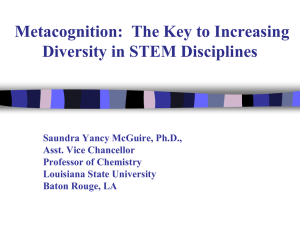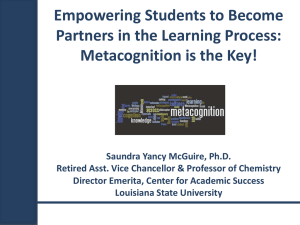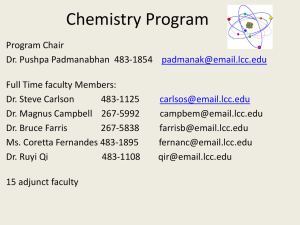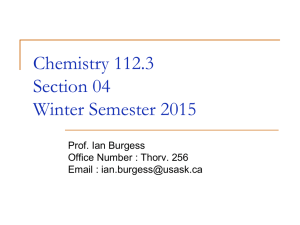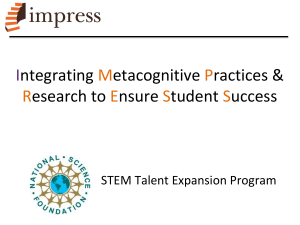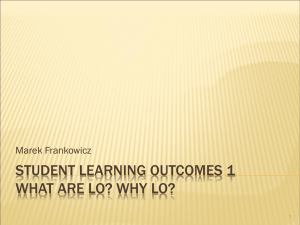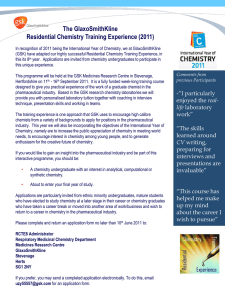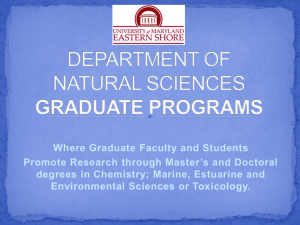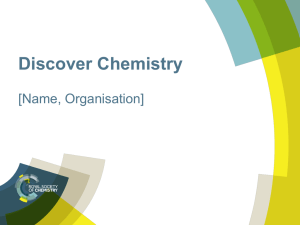HOW I LEARN
advertisement
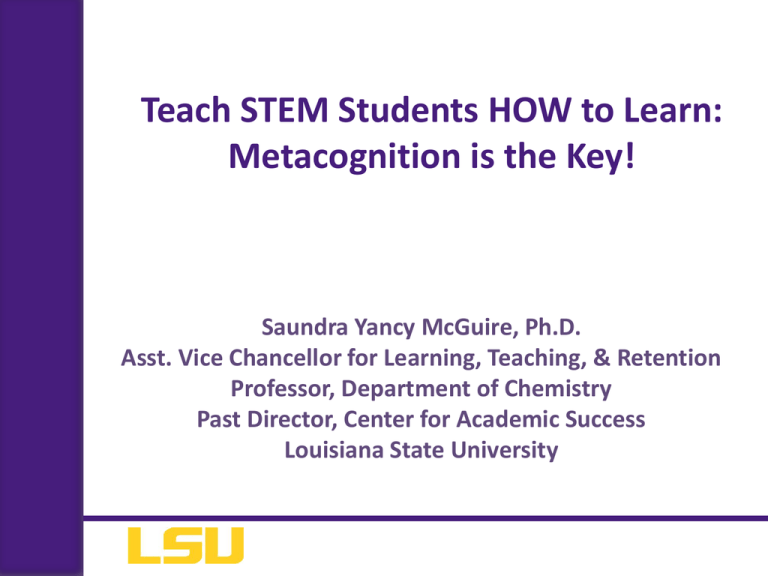
Teach STEM Students HOW to Learn: Metacognition is the Key! Saundra Yancy McGuire, Ph.D. Asst. Vice Chancellor for Learning, Teaching, & Retention Professor, Department of Chemistry Past Director, Center for Academic Success Louisiana State University 2004-2005 National College Learning Center Association Frank L. Christ Outstanding Learning Center Award Outline • Examples of Results of Teaching Students Metacognitive Strategies • Definition of Metacognition • Exercise Demonstrating Efficacy of Metacognitive Strategies • Bloom’s Taxonomy & The Study Cycle • Impact of Teaching Metacognitive Strategies During Class Sessions • Conclusion The Story of Four Students • Robert, first year chemistry student 42, 100, 100, 100 A in course • Dana, first year physics student 80, 54, 91, 97, 90 (final) A in course • Aaron, first year biology student 78, 92 A in course • Cici*, first year chemistry student 55, 60, 105** A in course * Learned strategies from chem instructor ** Due to bonus points Four Students in Professor Isiah Warner’s Fall 2005 Analytical Chemistry Class Test 1 Test 2 Test 3 Final Class Average Student 1 Student 2 Student 3 Student 4 76 65 67 70 83 52 67 65 46 55 72 61 68 68 65 78 107 88 88 90 Date of Final Exam: December 14, 2005 Meeting with Student No. 1: December 12, 2005 Meeting with Student Nos. 2 & 4: December 2, 2005 Meeting with Student No. 3: December 8, 2005 The final was worth 100 points with a 10 bonus question. How’d They Do It? They became expert learners by using metacognition! They learned to think about their own thinking, and they studied to LEARN, not just to make the grade! Metacognition* The ability to: • think about one’s own thinking • be consciously aware of oneself as a problem solver • monitor and control one’s mental processing (e.g. “Am I understanding this material?”) • accurately judge one’s level of learning *term coined by Flavell in 1976 Bransford, J.D., Brown, A.L., Cocking, R.R. (Eds.), 2000. How people learn: Brain, Mind, Experience, and School. Washington, DC: National Academy Press. Reflection Questions for Students • What’s the difference, if any, between studying and learning? Which, if either, is more enjoyable? Why? • How many hours per week, outside of class, did you study in high school? • Approximately how many hours per week do you think you will have to study in college? Approximately how many hours per week did you have to study to make A’s and B’s in high school? 1. 2. 3. 4. 5. 6. 7. 0–4 5–9 10 – 14 15 – 19 20 – 24 25 – 29 30 or more 62% 17% 14% 7% 1 2 3 4 0% 0% 0% 5 6 7 Approximately how many hours per week do you think you’ll have to study to make A’s in college? 34% 1. 2. 3. 4. 5. 6. 7. 0–4 5–9 10 – 14 15 – 19 20 – 24 25 – 29 30 or more 17% 14% 14% 11% 9% 0% 1 2 3 4 5 6 7 Faculty Must Help Students Make the Transition to College Help students identify and close “the gap” current behavior current grades efficacious behavior desired grades Counting Vowels in 45 seconds How accurate are you? Dollar Bill Dice Tricycle Four-leaf Clover Hand Six-Pack Seven-Up Octopus Cat Lives Bowling Pins Football Team Dozen Eggs Unlucky Friday Valentine’s Day Quarter Hour How many words or phrases do you remember? Let’s look at the words again… What are they arranged according to? Dollar Bill Dice Tricycle Four-leaf Clover Hand Six-Pack Seven-Up Octopus Cat Lives Bowling Pins Football Team Dozen Eggs Unlucky Friday Valentine’s Day Quarter Hour NOW, how many words or phrases do you remember? What were two major differences between the first attempt and the second attempt? 1. We knew what the task was 2. We knew how the information was organized What we know about learning • Active learning is more lasting than passive learning -- Passive learning is an oxymoron* • Thinking about thinking is important – Metacognition** • The level at which learning occurs is important – Bloom’s Taxonomy*** *Cross, Patricia, “Opening Windows on Learning” League for Innovation in the Community College, June 1998, p. 21. ** Flavell, John, “Metacognition and cognitive monitoring: A new area of cognitive– developmental inquiry.” American Psychologist, Vol 34(10), Oct 1979, 906-911. *** Bloom Benjamin. S. (1956). Taxonomy of Educational Objectives, Handbook I: The Cognitive Domain. New York: David McKay Co Inc. Bloom’s Taxonomy Anderson & Krathwohl, 2001 http://projects.coe.uga.edu/epltt/index.php?title=Bloom's_Taxonomy Combining information to form a unique product; requires creativity and originality. Evaluation Synthesis Using information to solve problems; transferring abstract or theoretical ideas to practical situations. Identifying connections and relationships and how they apply. Application Comprehension Restating in your own words; paraphrasing, summarizing, translating. Knowledge Louisiana State University Center for Academic Success B-31 Coates Hall 225-578-2872 www.cas.lsu.edu High School Memorizing verbatim information. Being able to remember, but not necessarily fully understanding the material. Identifying components; determining arrangement, logic, and semantics. Undergraduate Analysis Making decisions and supporting views; requires understanding of values. Graduate School Bloom’s Taxonomy This pyramid depicts the different levels of thinking we use when learning. Notice how each level builds on the foundation that precedes it. It is required that we learn the lower levels before we can effectively use the skills above. When we teach students about Bloom’s Taxonomy… They GET it! At what level of Bloom’s did you have to operate to make A’s or B’s in high school? 35% 1. 2. 3. 4. 5. 6. Knowledge Comprehension Application Analysis Synthesis Evaluation 25% 21% 13% 1 2 3 4 3% 3% 5 6 At what level of Bloom’s do you think you’ll need to be to make an A in college? 35% 1. 2. 3. 4. 5. 6. Knowledge Comprehension Application Analysis Synthesis Evaluation 23% 15% 14% 7% 6% 1 2 3 4 5 6 How do we teach students to move higher on Bloom’s Taxonomy? Teach them the Study Cycle* *adapted from Frank Christ’s PLRS system The Study Cycle 34 Reflect Review Preview Preview before class – Skim the chapter, note headings and boldface words, review summaries and chapter objectives, and come up with questions you’d like the lecture to answer for you. Attend Attend class – GO TO CLASS! Answer and ask questions and take meaningful notes. 4 Reflect Review Study Assess Review after class – As soon after class as possible, read notes, fill in gaps and note any questions. Study – Repetition is the key. Ask questions such as ‘why’, ‘how’, and ‘what if’. • Intense Study Sessions* - 3-5 short study sessions per day • Weekend Review – Read notes and material from the week to make connections Assess your Learning – Periodically perform reality checks • Am I using study methods that are effective? • Do I understand the material enough to teach it to others? *Intense Study Sessions Decide what you want to accomplish in your study session 1 Set a Goal 2 Study with Focus (30-50 min) Interact with material- organize, concept map, summarize, process, re-read, fill-in notes, reflect, etc. 3 Reward Yourself (10-15 min) Take a break– call a friend, play a short game, get a snack 4 Review (1-2 min) (5 min) Go over what you just studied Center for Academic Success B-31 Coates Hall ▪ 225.578.2872 ▪www.cas.lsu.edu Further Identifying the “Gap” to Shift the Paradigm • Reflection questions What could I have done differently? • Comparison of successful vs non-successful student behaviors Reflection Question For which task would you study more? A. Make an A on the test B. Teach the material to the class Top 5 Reasons Folks Did Not Make an A on First Chemistry Test 1. Didn’t spend enough time on the material 2. Started the homework too late 3. Didn’t memorize the information I needed to 4. Did not use the book 5. Assumed I understood information that I had read and re-read, but had not applied Top 5 Reasons Folks Made an A on Test 1: 1. Did preview-review for every class 2. Did a little of the homework at a time 3. Used the book and did the suggested problems 4. Made flashcards of the information to be memorized 5. Practiced explaining the information to others Concept maps facilitate development of higher order thinking skills And there are many different forms of concept maps… Chapter Map Title of Chapter Primary Headings Subheadings Secondary Subheadings Compare and Contrast Concept #1 Concept #2 How are they similar? How are they different? Do you have unprepared students? Gabriel, Kathleen F. (2008) Teaching Unprepared Students. Sterling, VA: Stylus Publishing Effective Strategies for Teaching Unprepared Students* • Establish high expectations • Emphasize Consistent Contact • Determine Students’ Learning Styles • Define Student Success • Clarify Student Responsibility • Establish a Learning Community of Scholars • Meet Students Where They Are • Interweave Assessment and Teaching *Kathleen Gabriel, Stylus Publishing, 2008 LSU Analytical Chemistry Graduate Student’s Cumulative Exam Record 2004 – 2005 2005 – 2006 9/04 Failed 10/05 Passed 10/04 Failed 11/05 Failed 12/05 Passed best in group 1/06 Passed 2/06 Passed Began work with CAS and the Writing Center in October 2005 11/04 Failed 12/04 Failed 1/05 Passed 2/05 Failed 3/06 Failed 3/05 Failed 4/06 Passed last one! 4/05 Failed 5/06 N/A Dr. Algernon Kelley, December 2009 The Impact of Using Metacognitive Strategies “Without these strategies, I probably would have gotten a C in chemistry. You showed us the first week a way to get an A in the class and I knew that was going to be my only way to achieve that A. I was planning on just studying before the test. But when you stressed how important it was to preview and review and study 2 hours a day or so, I was in shock, but I followed the guideline and got myself an A. So, I would like to thank you, because without these strategies, I probably would have done terribly in Chemistry.” Fall 2009 First semester chemistry student What happens when we teach metacognitive learning strategies, Bloom’s Taxonomy, and the Study Cycle to an entire class, not just individuals? The story of General Chemistry I in 2008, 2009, 2010, and 2011: what happens when we teach metacognitive strategies to an entire class?* *Cook, Elzbieta and Saundra McGuire. 2011. “Is less more? How much, when and how to teach learning strategies in General Chemistry courses”. Poster presented at the spring national meeting of the American Chemical Society, Anaheim, CA. What was done in 2008 and 2009 in General Chemistry I In 2008 and 2009, students lacking math skills (Math ACT score < 24) were allowed to take Gen Chem I. However, they had to • co-enroll in College Algebra • enroll in a 1-credit hour supplemental chemistry course (Chem 1200), in which study and learning strategies, as well as problem solving skills, were taught throughout the semester in a weekly 75 minute review session. Gen. Chem. I Results for Students with MATH ACT score < 24 Before CHEM 1200 2006 Cook 2007 Combined Instructors Cook Combined Instructors %ABC 47 54 46 47 %DFW 53 46 54 53 Performance in Gen Chem I based on Chem 1200 attendance 2008 1200 (≥75% sessions) 2009 No-1200 (N = 191; 86%) 1200 (≥75% sessions) No-1200 (N = 157; 64%) A B C D F W 15.71 29.84 32.98 18.32 3.14 − 33.05 26.87 15.78 8.96 8.10 7.25 12.01 24.20 43.95 12.73 5.10 1.91 29.82 25.06 21.55 6.02 8.77 8.77 ABC DFW 78.53 21.47 75.69 24.31 80.25 19.75 76.44 23.55 What was done in 2010 and 2011? • No students with ACT math scores < 24 were allowed in Gen Chem I • No Chem 1200 was offered. • But, study and learning strategies were taught in one 50-min class immediately after the results of Exam 1 were announced. Fall 2010 chain of events… Aug. 23: 657 students were enrolled at the start of the course Sept. 25: 632 students took Exam 1: • 123 (19.5%) students failed Exam 1 • 86 students failed Exam 1 but stayed in the course Sept. 27: 461 students attended McGuire’s talk; 156 did not Oct. 20: 617 students took Exam 2 Exam 1 Avg.: Attended 72.35% Absent 70.11% Improvement on Exam 2: Decline on Exam 2: No change on Exam 2: 230 (50%) 127 (27.5%) 104 (22.5%) 55 (35%) 70 (45%) 31 (20%) Fall 2010 chain of events… Aug. 23: 657 students were enrolled at the start of the semester Sept. 25: 461 students attended McGuire’s talk; 156 did not Oct. 20: 617 students took Exam 2 Exam 1 Avg.: Attended 72.35% Absent 70.11% Exam 2 Avg.: 76.01% 68.74% Exam 1 to Exam 2 Change +3.66% -1.37% Net change: + +5.03% One 50-min presentation on study and learning strategies resulted in an improvement of over 1/2 of a letter grade Performance in Gen Chem I in 2010 Based on One Learning Strategies Session Exam 1 Avg.: Exam 2 Avg.: Final course Avg*.: Final Course Grade: Attended 72.35% 76.01% 82.48% B Absent 70.11% 68.74% 72.61% C Even one 50-min presentation on study and learning strategies may mean an improvement of one full letter grade! Note: 15% of the final course grade was determined by homework; students could also earn ~5% for extra credit activities. Fall 2011 chain of events… Aug. 22: 718 students were enrolled at the start of the semester Sept. 23: 502 students attended McGuire’s talk; 216 did not Oct. 11: 695 students took Exam 2 Exam 1 Avg.: Attended 71.65% Absent 70.45% Entire Class 71.30% Exam 2 Avg.: 77.18% 68.90% 74.74% Exam 1 to Exam 2 Change +5.53% -1.55% +3.34% Net change: +7.08% One 50-min presentation on study and learning strategies resulted in an improvement of over 2/3 of a letter grade Performance in Gen Chem I in 2011 Based on One Learning Strategies Session Exam 1 Avg.: Exam 2 Avg.: Final course Avg*.: Final Course Grade: Attended 71.65% 77.18% 81.60% B Absent 70.45% 68.90% 70.43% C The one 50-min presentation on study and learning strategies again resulted in an improvement of one full letter grade! Note: 15% of the final course grade was determined by homework; students could also earn ~5% for extra credit activities. Performance in Organic Chem I Based on One Learning Strategies Session Fall 2011 Exam 1 Avg.: Exam 2 Avg.: Attended 67.95% 71.36% Absent 74.04% 70.39% Change +3.41% -3.65% Net Change +7.06% One 50-min presentation on study and learning strategies again resulted in an improvement of over 2/3 of a letter grade on Exam 2 Intro Chem Results Spring 2007 Test 1 Test 2 Attended lecture 156 on metacog. 3/2* Final Total points 109 214 801 (B) Did not attend 154 93 153 563 (D) Class average 153 100 176 662 (C) *Approximately 80 attendees out of 200 students because session was on a Friday afternoon. Exam 1 was Wednesday, March 7. Important Reading Dweck, Carol, 2006. Mindset: The New Psychology of Success. New York: Random House Publishing Shenk, David, 2010. The Genius in All of Us: Why Everything You've Been Told About Genetics, Talent, and IQ Is Wrong. New York: Doubleday Mindset* Matters! Fixed Intelligence Mindset Intelligence is static You have a certain amount of it Growth Intelligence Mindset Intelligence can be developed You can grow it with actions Dweck, Carol (2006) Mindset: The New Psychology of Success. New York: Random House Publishing Mindset determines reactions to • Challenges – avoid vs. embrace • Obstacles – give up easily vs. persist • Tasks requiring effort – fruitless vs. path to mastery • Criticism – ignore vs. learn from • Success of Others – feel threatened by vs. find lessons and inspiration in Teaching and Learning Strategies That Work SCIENCE , VOL 325 4 SEPTEMBER 2009 www.sciencemag.org ROALD HOFFMANN1* AND SAUNDRA Y. MCGUIRE2 1Department of Chemistry and Chemical Biology, Cornell University, Baker Laboratory, Ithaca, NY 14853, USA. 2Center for Academic Success and Department of Chemistry, Louisiana State University, Baton Rouge, LA 70803, USA. September-October 2010 Volume 98, Number 5 MARGINALIA Learning and Teaching Strategies Roald Hoffmann and Saundra Y. McGuire Knowledge of Metacognition Greatly Increases URM Student Success They are less likely to have been cognitively challenged in high school They are less likely to be encouraged to stick with it They are more likely to experience the impact of a paradigm shift From Spring 2011 AA male Eng student… “…Personally, I am not so good at chemistry and unfortunately, at this point my grade for that class is reflecting exactly that. I am emailing you inquiring about a possibility of you tutoring me.” April 6, 2011 “I made a 68, 50, 50, 87, 87, and a 97 on my final. I ended up earning a 90 in the course, but I started with a 60. I think what I did different was make sidenotes in each chapter and as I progressed onto the next chapter I was able to refer to these notes. I would say that in chemistry everything builds from the previous topic” May 13, 2011 Semester GPA: 3.8 From a Xavier University student to Dr. Kelley in Fall 2011 Oct. 17, 2011 Hello Dr. Kelley. … I am struggling at Xavier and I REALLY want to succeed, but everything I've tried seems to end with a "decent" grade. I’m not the type of person that settles for decent. What you preached during the time you were in Dr. Privett's class last week is still ringing in my head. I really want to know how you were able to do really well even despite your circumstances growing up. I was hoping you could mentor me and guide me down the path that will help me realize my true potential while here at Xavier. Honestly I want to do what you did, but I seriously can't find a way how to. Can I please set up a meeting with you as soon as you’re available so I can learn how to get a handle on grades and classes? Oct. 24, 2011 Hey Dr. Kelley, I made an 84 on my chemistry exam (compared to the 56 on my first one) using your method for 2 days (without prior intense studying). Thanks for pointing me in the right direction. I’ll come by your office Friday and talk to you about the test. Nov 3, 2011 Hey Dr. Kelley! I have increased my Bio exam grade from a 76% to a 91.5% using your system. Ever since I started your study cycle program, my grades have significantly improved. I have honestly gained a sense of hope and confidence here at Xavier. My family and I are really grateful that you have taken time to get me back on track. LA-STEM RESEARCH SCHOLARS PROGRAM: AN AMAZING SUCCESS STORY! Louisiana State University Innovative Educators Webinar 213 2010 Hatcher Hall October 20, Office of Strategic Initiatives Center for Academic Success Transform Learning. Maximize Performance. LA-STEM SCHOLARS Percentage of total Scholars Served by Ethnicity &Gender: 2003-2011 Females Males 60 50 40 30 20 10 0 American American Indian Indian Asian/Pacific Asian/Pacific Islander Islander Black Black Hispanic Hispanic SIX-YEAR GRADUATION RATES Office of Office Strategic InitiativesInitiatives of Strategic IN White White STEM *LA-STEM Research Scholars Program Highly Selective Institutions Louisiana State University Selective Institutions Moderately Selective Institutions All 92.3% 49.6% 34.4% 37.6% 28.0% Male 96.0% 50.0% 38.4% 39.2% 28.5% Female 90.2% 46.7% 29.0% 34.6% 27.2% Black 92.3% 33.0% 26.7% 24.6% 12.5% Center for Academic Success Transform Learning. Maximize Performance. LA-STEM GRADUATES Columbia University Duke University Georgia Institute of Technology Massachusetts Institute of Technology Mount Sinai School of Medicine Rice University Texas A & M University The Ohio State University Tulane University University of Alabama University of California, Davis University of California, Irvine University of Florida at Gainesville University of Iowa University of Michigan University of North Carolina at Chapel Hill University of Texas/M.D. Anderson Cancer Center Office of Strategic Initiatives Office of Strategic Initiatives University of Washington University of Wisconsin-Madison Vanderbilt University School of Medicine Wake Forest University Washington University We can significantly increase student learning in STEM! • We must teach students the learning process and specific strategies • We must not judge student potential on initial performance • We must encourage students to persist in the face of initial failure • We must encourage the use of metacognitive tools Useful Websites • • • • • • www.cas.lsu.edu www.howtostudy.org www.vark-learn.com www.drearlbloch.com Searches on www.google.com www.khanacademy.org Additional References • Bruer, John T. , 2000. Schools For Thought: A Science of Learning in the Classroom. MIT Press. • Bransford, J.D., Brown, A.L., Cocking, R.R. (Eds.), 2000. How people learn: Brain, Mind, Experience, and School. Washington, DC: National Academy Press. • Christ, F. L., 1997. Seven Steps to Better Management of Your Study Time. Clearwater, FL: H & H Publishing • Cromley, Jennifer, 2000. Learning to Think, Learning to Learn: What the Science of Thinking and Learning Has to Offer Adult Education. Washington, DC: National Institute for Literacy. • Ellis, David, 2006. Becoming a Master Student*. New York: Houghton-Mifflin. • Hoffman, Roald and Saundra Y. McGuire. (2010). Learning and Teaching Strategies. American Scientist , vol. 98, pp. 378-382. • Nilson, Linda, 2004. Teaching at It’s Best: A Research-Based Resource for College Instructors. Bolton, MA: Anker Publishing Company. • Pierce, William, 2004. Metacognition: Study Strategies, Monitoring, and Motivation. http://academic.pg.cc.md.us/~wpeirce/MCCCTR/metacognition.htm *Excellent student reference Acknowledgments Dr. Elzbieta Cook, General Chem I Instructor Prof. Roald Hoffmann, mentor and collaborator Faculty in the LSU Chemistry Department Prof. Isiah Warner and the Office of Strategic Initiatives Sarah Baird & LSU Center for Academic Success National College Learning Center Association All of the students who changed their attitudes and behaviors and showed me what was possible! • Support provided by:

